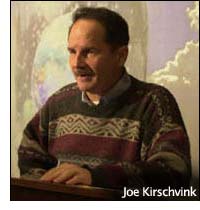 Joe Kirschvink
Joe Kirschvink, a
biomagnetist and
paleomagnetist at the Caifornia Institute of Technology in Pasadena, USA, coined the name “snowball earth”. He recognized its self-reversing character (building on earlier work by atmospheric scientists James Walker, Hal Marshall and Jim Kasting) and was the first to associate the runaway ice-
albedo concept to a known geological event, the
Marinoan glaciation. He proposed three independent tests of his hypothesis: global synchroneity, ocean
anoxia, and ultra-greenhouse aftermaths, each of which has been supported by new evidence. Kirschvink’s hypothesis was first presented in 1989 to a think-tank called the Proterozoic Paleobiology Research Group (PPRG) organized by
Bill Schopf at the University of California Los Angeles. It was published in 1992 as an unrefereed, seven-paragraph-long, article buried in a 1348-page book. The
article is a geological classic but fell short of what was needed to convince a skeptical audience of a radical idea. Initially and for several years afterwards, it was openly supported by only two other geologists, Cees Klein at the University of New Mexico (USA) and Nic Beukes at the Rand Afrikaans University in South Africa. Research activity ramped up (see
Bibliography) after a 1998 paper in the journal
Science by a group from Harvard University and extensive lecture tours by its lead author Paul Hoffman. They argued that the third of Kirschvink’s predictions (ultra-greenhouse aftermaths) could account for post-glacial ‘
cap carbonates‘ characteristic of the Marinoan snowball earth. Kirschvink’s genius was to bring three distinct disciplines to bear on the problem of apparent low-latitude glaciation: climate physics (the ice-albedo feedback instability of Buyko and Sellers), geochemistry (the silicate rock
weathering feedback of James Walker and coauthors) and geology (glacial sedimentology and Kirschvink’s own discipline of paleomagnetism, earlier combined by Brian Harland). Kirschvink originally set out to disprove low-latitude glaciation but was compelled by his own data to support it.
 Joe Kirschvink, a biomagnetist and paleomagnetist at the Caifornia Institute of Technology in Pasadena, USA, coined the name “snowball earth”. He recognized its self-reversing character (building on earlier work by atmospheric scientists James Walker, Hal Marshall and Jim Kasting) and was the first to associate the runaway ice-albedo concept to a known geological event, the Marinoan glaciation. He proposed three independent tests of his hypothesis: global synchroneity, ocean anoxia, and ultra-greenhouse aftermaths, each of which has been supported by new evidence. Kirschvink’s hypothesis was first presented in 1989 to a think-tank called the Proterozoic Paleobiology Research Group (PPRG) organized by Bill Schopf at the University of California Los Angeles. It was published in 1992 as an unrefereed, seven-paragraph-long, article buried in a 1348-page book. The article is a geological classic but fell short of what was needed to convince a skeptical audience of a radical idea. Initially and for several years afterwards, it was openly supported by only two other geologists, Cees Klein at the University of New Mexico (USA) and Nic Beukes at the Rand Afrikaans University in South Africa. Research activity ramped up (see Bibliography) after a 1998 paper in the journal Science by a group from Harvard University and extensive lecture tours by its lead author Paul Hoffman. They argued that the third of Kirschvink’s predictions (ultra-greenhouse aftermaths) could account for post-glacial ‘cap carbonates‘ characteristic of the Marinoan snowball earth. Kirschvink’s genius was to bring three distinct disciplines to bear on the problem of apparent low-latitude glaciation: climate physics (the ice-albedo feedback instability of Buyko and Sellers), geochemistry (the silicate rock weathering feedback of James Walker and coauthors) and geology (glacial sedimentology and Kirschvink’s own discipline of paleomagnetism, earlier combined by Brian Harland). Kirschvink originally set out to disprove low-latitude glaciation but was compelled by his own data to support it.
Joe Kirschvink, a biomagnetist and paleomagnetist at the Caifornia Institute of Technology in Pasadena, USA, coined the name “snowball earth”. He recognized its self-reversing character (building on earlier work by atmospheric scientists James Walker, Hal Marshall and Jim Kasting) and was the first to associate the runaway ice-albedo concept to a known geological event, the Marinoan glaciation. He proposed three independent tests of his hypothesis: global synchroneity, ocean anoxia, and ultra-greenhouse aftermaths, each of which has been supported by new evidence. Kirschvink’s hypothesis was first presented in 1989 to a think-tank called the Proterozoic Paleobiology Research Group (PPRG) organized by Bill Schopf at the University of California Los Angeles. It was published in 1992 as an unrefereed, seven-paragraph-long, article buried in a 1348-page book. The article is a geological classic but fell short of what was needed to convince a skeptical audience of a radical idea. Initially and for several years afterwards, it was openly supported by only two other geologists, Cees Klein at the University of New Mexico (USA) and Nic Beukes at the Rand Afrikaans University in South Africa. Research activity ramped up (see Bibliography) after a 1998 paper in the journal Science by a group from Harvard University and extensive lecture tours by its lead author Paul Hoffman. They argued that the third of Kirschvink’s predictions (ultra-greenhouse aftermaths) could account for post-glacial ‘cap carbonates‘ characteristic of the Marinoan snowball earth. Kirschvink’s genius was to bring three distinct disciplines to bear on the problem of apparent low-latitude glaciation: climate physics (the ice-albedo feedback instability of Buyko and Sellers), geochemistry (the silicate rock weathering feedback of James Walker and coauthors) and geology (glacial sedimentology and Kirschvink’s own discipline of paleomagnetism, earlier combined by Brian Harland). Kirschvink originally set out to disprove low-latitude glaciation but was compelled by his own data to support it.